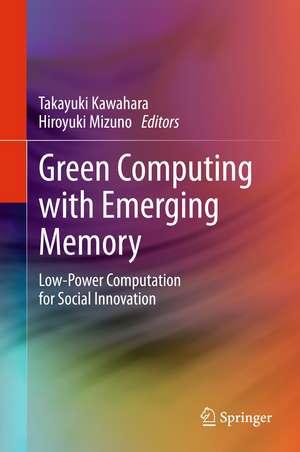Green Computing with Emerging Memory: Low-Power Computation for Social Innovation
Editat de Takayuki Kawahara, Hiroyuki Mizunoen Limba Engleză Hardback – 27 sep 2012
| Toate formatele și edițiile | Preț | Express |
|---|---|---|
| Paperback (1) | 693.25 lei 43-57 zile | |
| Springer – 23 aug 2016 | 693.25 lei 43-57 zile | |
| Hardback (1) | 640.06 lei 43-57 zile | |
| Springer – 27 sep 2012 | 640.06 lei 43-57 zile |
Preț: 640.06 lei
Preț vechi: 753.01 lei
-15% Nou
Puncte Express: 960
Preț estimativ în valută:
122.51€ • 133.12$ • 102.98£
122.51€ • 133.12$ • 102.98£
Carte tipărită la comandă
Livrare economică 21 aprilie-05 mai
Preluare comenzi: 021 569.72.76
Specificații
ISBN-13: 9781461408116
ISBN-10: 1461408113
Pagini: 224
Ilustrații: VII, 213 p.
Dimensiuni: 155 x 235 x 18 mm
Greutate: 0.41 kg
Ediția:2012
Editura: Springer
Colecția Springer
Locul publicării:New York, NY, United States
ISBN-10: 1461408113
Pagini: 224
Ilustrații: VII, 213 p.
Dimensiuni: 155 x 235 x 18 mm
Greutate: 0.41 kg
Ediția:2012
Editura: Springer
Colecția Springer
Locul publicării:New York, NY, United States
Public țintă
ResearchCuprins
Introduction.- Low-Power Electron Devices.- Low-Power Spin Devices.- Low-Power SRAM.- Low-Power DRAM.- Low-Power NV-RAM.- On-Chip Power Gating Technique.- Low-Power Processing with NV-RAM.- Closing.
Textul de pe ultima copertă
This book describes computing innovation, using non-volatile memory for a sustainable world. It provides a compact overview of a green computing scheme, including cutting-edge CMOS low-power devices, comprehensive spintronics knowledge, trends in low-volatile memory and non-volatile RAM, low voltage (low leakage) computing circuits and systems, and a low-power computing plan that uses non-volatile memory. Coverage should appeal both to computing engineers and device engineers, as the authors describe a new means of lower power computing innovation, without sacrificing performance over conventional low-voltage operation. Readers will be introduced to methods of design and implementation for non-volatile memory which allow computing equipment to be turned off normally when not in use and to be turned on instantly to operate with full performance when needed.
· Provides a comprehensive introduction to current low-power innovation, low-voltage technology and non-volatile memory technology;
· Includes an overview of leading-edge CMOS low-power devices and spintronics technology;
· Describes trends in low-voltage SRAM and low-voltage DRAM, providing readers with power management insight, showing the evolution of the interface between memory and processor and the predicted development of memory hierarchy systems in the future;
· Describes in detail STT-RAM (or SPRAM, spin-transfer torque RAM) technology and its potential for achieving low power consumption and high performance;
· Covers low-power computing technology at the circuits and systems levels, including the latest low-voltage computing technology being used to prevent leakage currents, as well as a description of an instantaneous on/off system using non-volatile RAMs, which can serve as an example for future green computing.
· Provides a comprehensive introduction to current low-power innovation, low-voltage technology and non-volatile memory technology;
· Includes an overview of leading-edge CMOS low-power devices and spintronics technology;
· Describes trends in low-voltage SRAM and low-voltage DRAM, providing readers with power management insight, showing the evolution of the interface between memory and processor and the predicted development of memory hierarchy systems in the future;
· Describes in detail STT-RAM (or SPRAM, spin-transfer torque RAM) technology and its potential for achieving low power consumption and high performance;
· Covers low-power computing technology at the circuits and systems levels, including the latest low-voltage computing technology being used to prevent leakage currents, as well as a description of an instantaneous on/off system using non-volatile RAMs, which can serve as an example for future green computing.
Caracteristici
Provides a comprehensive introduction to current low-power innovation, low-voltage technology and non-volatile memory technology Describes a new form of low-power computing innovation, known as “normally-off/instant-on” computing, which achieves drastic power reduction without sacrificing performance Appeals to computing engineers with novel content about non-volatile memory and device engineers with content about computing innovation Includes supplementary material: sn.pub/extras




























